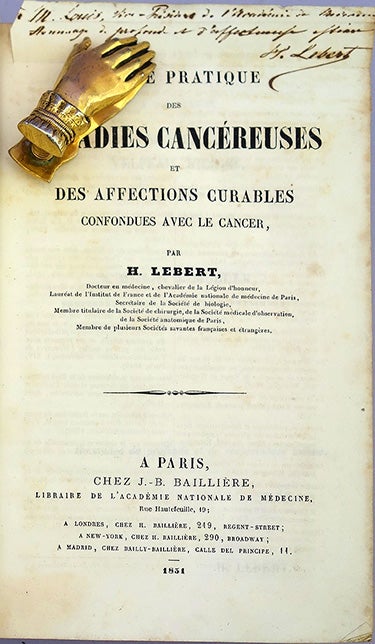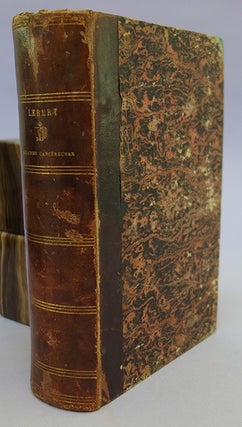Traite pratique des maladies cancereuses et des affections curables confondues avec le cancer
Publisher Information: Paris: J.-B. Bailliere, 1851.
Inscribed Presentation Copy
Lebert, Hermann (1813-78). Traité pratique des maladies cancéreuses et des affections curables confondues avec le cancer. xxvi, 892pp. Paris: J.-B. Baillière [etc.], 1851. 208 x 133 mm. 19th century quarter morocco, marbled boards, vellum corners, light rubbing and wear. Minor foxing but fine otherwise. Presentation copy, with Lebert’s signed autograph inscription on the title: “à M. Louis, Vice-Président de l’Académie de Médecine Hommage de profonde et d’affectueuse estime H. Lebert.”
First Edition. Lebert was one of the foremost cancer researchers of the nineteenth century, and the Traité pratique des maladies cancéreuses was his principal work on the subject. Using the histological methods developed by Johannes Müller, Lebert studied cancer cells under high magnification in order to discover the specific elements distinguishing them from normal cells. He classified tumors as either homeomorphous (composed of elements analogous to those of the normal organism) or heteromorphous (composed of elements having no analogy in the body). Lebert’s treatise “described the characteristics of malignant cells, their variation of sizes, and noted the commonly increased size of the nucleus compared to the cytoplasm (later known as the ‘karyoplasmic ratio’). This is the first description of altered karyoplasmic ratios in cancer cells. Alteration of karyoplasmic ratios is a morphometric criterion still used today in diagnostics” (De las Heras and Schirmer, p. 8). “Lebert characterized the cancer cell itself as follows: ‘The pattern of the cancerous cell is that of a small regular sphere with an elliptical nucleus, placed eccentrically, occupying almost half or even more of the inside and enclosing one or several big nucleoli’” (Wolff, p. 109). Assuming that only tumors containing this type of cell could be considered cancers, Lebert excluded several types of tumors that had previously been classed as cancerous, calling these tumors “pseudocancer” and “cancroid.”
A native of Breslau (now Wroclaw, Poland), Lebert studied medicine and natural science in Berlin, Zurich, and in Paris, where his primary teachers were Guillaume Dupuytren and Pierre-Charles-Alexandre Louis. Much of his career was spent in Switzerland, at first in the town of Bex (canton of Vaud), and later in Zurich, where he held the post of professor of clinical medicine from 1853 to 1859. In 1859 Lebert was invited to succeed Friedrich Theodor Frerichs as professor of clinical medicine and director of the hospital at Breslau. In 1879 he returned to Bex where he spent the remainder of his life. Lebert was one of the first to use the microscope in pathological anatomy.
Lebert inscribed this copy to Dr. Louis, vice-president of the Académie de Médecine; this may refer to Pierre-Charles-Alexandre Louis (1787-1872), whose “numerical method” for evaluating therapies was an ancestor of the modern clinical trial. De las Heras & Schirmer, “The nuclear envelope and cancer: A diagnostic perspective and historical overview,” in Cancer Biology and the Nuclear Envelope (2014), pp. 5-26). Garrison-Morton (online) 6965. Wolff, The Science of Cancerous Disease from Earliest Times to the Present (1907; tr. 1989), 109-11.
Book Id: 43421Price: $1,500.00



